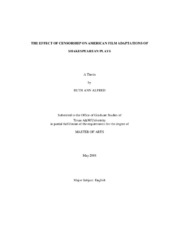| dc.description.abstract | From July 1, 1934, to November 1, 1968, the Production Code Administration
(PCA) oversaw the creation of American motion pictures, in order to improve
Hollywood’s moral standing. To assist in this endeavor, the studios produced film
adaptations of classic literature, such as the plays of William Shakespeare. In the first
two years of the Code’s inception, two Shakespearean films were produced by major
studios: A Midsummer Night’s Dream (1935) and Romeo and Juliet (1936). But were
these classic adaptations able to avoid the censorship that other films endured? With the
use of archived collections, film viewings, and an in-depth analysis of the plays, multiple
versions of the scripts, and other available surviving documents, I was able to see how
these productions were affected by the enforcement of film censorship and what it said
about the position of Shakespeare’s work in society.
A Midsummer Night’s Dream tended to use self-regulation, so as to avoid the
censorship of the PCA. However, the film did not escape without some required
changes. In spite of the filmmakers’ efforts, there were a few textual changes and the
fairy costumes required revisions to meet the PCA’s standards. In the case of Romeo and Juliet, the PCA was far more involved in all stages of
the film’s production. There were many documented text changes and even a case in
which the censors objected to how the actors and director executed a scene on film. The
motion picture was created as if it were of the greatest importance by all involved. And,
as it were, the existing archives paint a picture of a production that was a sort of
battleground in a sociopolitical war between the censors and the filmmakers.
As both films arrived on the international stage, this sociopolitical campaigning
did not end. During international distribution, the films were each accepted, rejected,
and forced to endure further censorship, in order to become acceptable for public
screening. This censorship often relayed a message about the location’s societal views
and its contrast to American society. | en |


